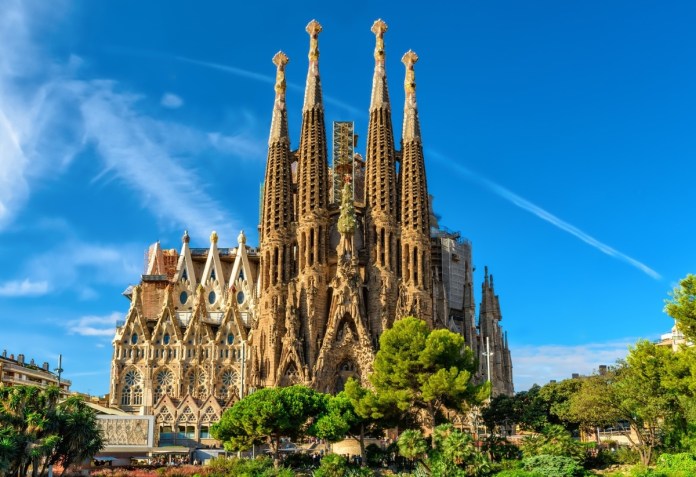Most of the urban Indian population got introduced to the charms of Spain via Zoya Akhtar’s Zindagi Na Milegi Dobara. But what’s shown in the movie is probably just 10% of how gorgeous, historic and interesting the country is! True, Spain is popular for its food, lovely beaches, a lot of sunshine, historical monuments. But there’s just so much more to this place than meets the eye. And of the major facts which prove this point is Spain’s La Sagrada Familia Church- the insanely huge and beautiful building which is under construction since 1882. Yes! That makes it 137 years and counting in the making. No kidding! That is longer than the Egyptian Pyramids took to build! It’s still under construction and is expected to be completed in 2026. For now, it is the largest unfinished Roman Catholic church in Barcelona. But it’s expected to be the tallest church in the whole wide world, once it is completed. It all sounds unreal, right? But as jaw-dropping as it sounds, it is all true! Which is why we simply had to dig deeper and know all about this unique structure in the making.

Image Source: sagradafamilia.org 
Image Source: sagradafamilia.org
Image Source: sagradafamilia.org
History of Sagrada Familia Church
The story of the famous spot begins in 1874 when a local religious organization (Spiritual Association of the Devotees of Saint Joseph) began campaigning in favour of the construction of a church honouring the Holy Family. The plans were drawn up, and the cornerstone of the church was laid on March 19, 1882. This kicked off the construction under the supervision of the Temple’s first architect Francisco de Paula del Villar y Lozano. And then after a short while, due to differences of opinion with the developers, Francisco stepped down and the position was given to Antoni Gaudí.

And by 1923, Antoni had finalized his sketches for the church and then there was no looking back for him. The central nave vaulting was completed in 2000. Sagrada Família Schools building which was made by Gaudi now has an exhibition house. In 2012, Barcelona-born architect Jordi Fauli took over as chief architect and continues to oversee the construction till date.
All About The Jaw-Dropping Architecture

Image Source: Facebook/BasilicadelaSagradaFamilia 
Image Source: Facebook/BasilicadelaSagradaFamilia
Image Source: Facebook/BasilicadelaSagradaFamilia
Image Source: Facebook/BasilicadelaSagradaFamilia
Image Source: Facebook/BasilicadelaSagradaFamilia
Despite being in a construction phase, each year more than 3 million visitors visit this attraction. And while the jaw-dropping interior of the church certainly speaks for itself, we are sure you want to know everything about the architecture.
Gaudi has always been known for his distinctive and inventive design. Instead of hard lines and sharp angles, his dimensions are more organic and flowy. The exteriors of the church have drawn inspiration from the Gothic styles of the Middle Ages. On the outside of each entrance of the building, Biblical scenes are depicted, making it more gorgeous. Once you step inside, you’ll feel as if you’ve been transported to a wonderland because of the bright colours, curving angles, and unusual forms. The massive stain glass windows brighten up the interior and create colour splashes across the entire floor. You’ll definitely feel like you’re in a movie!
Currently, the church houses 8 towers. By the end of construction, it will have a total of 18 towers with 12 of them representing the 12 apostles (the primary disciples of Jesus), 4 representing the 4 evangelists (preacher), 1 representing the Virgin Mary (mother of Jesus), and the tallest and central tower will represent Jesus.

Image Source: Facebook/BasilicadelaSagradaFamilia
Image Source: Facebook/BasilicadelaSagradaFamilia
Image Source: Facebook/BasilicadelaSagradaFamilia
Image Source: Facebook/BasilicadelaSagradaFamilia
Image Source: Facebook/BasilicadelaSagradaFamilia
Amazing Facts on One of The Most Wondrous Cathedrals
- In 2005, La Sagrada Familia was designated as a UNESCO World Heritage Site. Because of its unique architecture and Gaudi’s ability to create such an artistic place, this badge was designated. Not a surprise, La Sagrada Familia is one of seven buildings by Antoni Gaudí that fall under this category.
- Currently, the Ulmer Münster church in Germany is the tallest standing church in the world with 162 feet height. And if by 2026, Sagrada Familia is completed it will be the tallest church in the world! The central tower in the middle will reach about 172 meters tall.
- Stones of the iconic church were sourced from Montjuïc, a hill where Gaudi built his famous architecture park, Parc Güell. Gaudi chose this particular kind of sandstone because of its durability and because of its chromatic variability. The stones come in shades of grey, pink, brown and even blue.
- The construction is being run by donations. And the 3 million visitors every year is a great support to the project. It costs nearly costs around 25 million euros annually.

Image Source: Facebook/BasilicadelaSagradaFamilia
Image Source: Facebook/BasilicadelaSagradaFamilia
Image Source: Facebook/BasilicadelaSagradaFamilia
- After the death of Antoni Gaudí from a tram accident in 1926, he was buried in a stone-walled crypt inside the Chapel of the Virgin of El Carmen in the underground crypt of the church.
- When the Spanish Civil War broke out in 1936, a group of people had destroyed most of Gaudi’s blueprints, drawings, and plaster models. And then it took researchers 16 years to reassemble the lost documents.
- By 2026, architectures are planning to finish it up as it’s going to be Antoni Gaudi’s 100th death anniversary.
- 150 years is a pretty long time and just think once by the time La Sagrada Familia is completed, it will have taken longer to build than the Egyptian Pyramids. And about 50 years less than the Great Wall of China.
- During the early days of the construction, Gaudí built a school on the site called the Sagrada Familia Schools building. The school is now the site of an exhibition on the Sagrada Familia.
Status of The Construction

Image Source: Facebook/BasilicadelaSagradaFamilia
Image Source: Facebook/BasilicadelaSagradaFamilia
More than a century after it was first commissioned, Barcelona’s iconic landmark Sagrada Familia Church still remains unfinished. The church is still under construction and it’s been said that it’s going to be completed by 2026—a century after Catalan architect Antoni Gaudí’s death.
Back in October 2015, the Chief architect Jordi Fauli announced that construction is 70 per cent complete and has entered its final phase. Most of the church’s structure is said to be completed by 2026. But the centennial of Gaudí’s death and decorative elements will take time and is said to be completed by 2030 or 2032.

Image Source: Facebook/BasilicadelaSagradaFamilia
Image Source: Facebook/BasilicadelaSagradaFamilia
Image Source: Facebook/BasilicadelaSagradaFamilia
Trust us even if you visit now you will be surprised with the interiors and you can spend hours in this church just appreciating its beauty and marvel. Above all, if you visit here, you’ll literally be able to see history come alive in front of your eyes. Need we say more?
(Featured Image Source: lonelyplanet)




